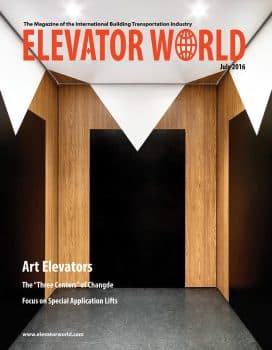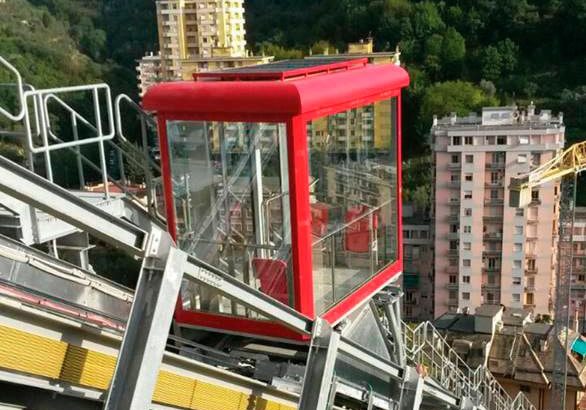Tall Buildings and the Sabbath Elevator
Jul 1, 2016

Technological innovations in vertical transportation as they pertain to the ever-evolving Sabbath elevator and the differing reactions to them within Jewish law
“Six days you shall labor and do all your work, but the seventh day is a Sabbath to the Lord your God. On it you shall not do any work. . .”
– Ex odus 20:9-10
The commandment to keep the Sabbath as a day of rest appears in the Bible many times. Jewish law prescribes an intricate set of rules regarding which activities may be performed and which are prohibited. Operating electric switches is among the prohibited actions. Accordingly, persons who strictly observe the Sabbath would appear to be restricted or excluded from living on the upper floors of tall buildings or partaking in activities in multifloor public buildings. This situation has widespread implications as to where such persons can live and their full integration into society.
The solution to this issue – which has been evolving for more than 50 years – is the Sabbath elevator. A Sabbath elevator is an elevator that operates in a special automatic mode as a way to circumvent the prohibition of operating electric switches on the Sabbath. Sabbath elevators can typically be found in Israel, where they are mandated by law, and in other countries with large Jewish populations, including the U.S., Canada, Ukraine, England, France, Argentina and Brazil. These elevators enable observant Jews to reside in tall buildings and take full advantage of facilities in hotels, hospitals, synagogues and other public buildings.
The Sabbath elevator is typically marked with a sign that is illuminated to indicate when it is operating in the Sabbath mode. At such times, the elevator will stop automatically at all floors on both the up and down trips, or it might go up directly to the top floor, then stop at each floor while going down.
This article summarizes the technological innovations in vertical transportation as they pertain to the Sabbath elevator and the differing reactions to them within Jewish law. It further examines their technical, social and communal impacts on tall buildings and the skyscraper city.
Jewish Law
The basic approach of using technological solutions to circumvent Sabbath prohibitions has been around since the 19th century but is based on far earlier sources, which even preceded the use of electricity. It is now widely sanctioned by rabbinic Responsa (decisions and rulings made by Jewish scholars of historic Jewish law) and has become part of Jewish law for observing the Sabbath. For example, most Sabbath-observant homes use one or more clock timers for regulating electrical lights and appliances for air-conditioning and heating. The setting of a timer or clock that automatically trips circuits on and off appears to be in concert with a well-established Talmudic (Jewish oral law) discussion.
It is permitted to start an action (or labor) on Friday (before the Sabbath), even though that action will be completed on the Sabbath. This is because it is forbidden only to start work on the Sabbath. When the work is done by itself on the Sabbath, there is no prohibition barring benefit from that work (Babylonian Talmud, Shabbat 17b-18a and Rambam, Shabbat 3:1 Aramaic and Hebrew). Similarly, the Code of Jewish law posits that it is permitted to start an action on Friday near darkness (the start of the Sabbath), even though the work cannot be completed on Friday and can only be finished on the Sabbath (Shulchan Aruch, Orach Chaim 252:1 Hebrew).
Two exceptions to this rule are raised in the Talmud. The first states that one may not place a dish of water around a flame emitting sparks on Friday, as one may shift the dish on the Sabbath, thereby extinguishing the flame (Babylonian Talmud, Shabbat 47b Aramaic). The second exception revolves around a Talmudic discourse: Rava states that it is prohibited to add wheat on Friday to a water mill that runs automatically on the Sabbath, since the mill makes disturbing noise, which desecrates the Sabbath. Rav Yosef disagrees with Rava and permits any action done prior to the Sabbath, even if there is significant noise involved (Babylonian Talmud, Shabbat Aramaic). A majority of later rabbinic authorities accept Rav Yosef’s approach. However, some are concerned about resulting noticeable noise or visible action. This concern is allayed only when there is some significant need.
Leading 20th-century rabbinic authorities agreed that one should not play a radio (or, for that matter, a television), even if it is left on from before the Sabbath or turned on by a timer. It is analogous to putting wheat into a water mill. Both cause noise and arouse suspicion that the owner is violating the Sabbath.
During the Gulf War and other occasions when Israel was under missile attack, the Chief Rabbinate of Israel relaxed the radio prohibition on the Sabbath. The Broadcast Authority accommodated its religious listeners by setting up a “silent broadcast.” The radio, although left on, only broadcast when there was a need to advise the population of an imminent missile attack and the need to take shelter. Obviously, these situations are among those that can be deemed “significant need.”
The Sabbath elevator is an extension of the discussions and rulings regarding clock timers for electrical appliances. However, elevators appear to pose several further complications. Once again, there were different opinions regarding Sabbath elevators in the first half of the 20th century. One rabbinic source forbade using Sabbath elevators, based on the reasoning that the riders’ additional weight in the elevator causes it to work harder and draw more current. Another prohibiting voice based his ruling on the rabbinic precedent forbidding one to ride on a train or trolley on the Sabbath. This precedent is based on a Talmudic ruling that being transported in an enclosed chair carried by others conflicts with the spirit of the Sabbath (Babylonian Talmud, Beitzah 25b Aramaic). (In this instance, no distinction is made between horizontal or vertical transportation.)
Other leading rabbinic authorities took a different approach and permitted riding in an elevator so long as the rider performs no forbidden act of labor. The chief Ashkenazic rabbi of Israel in the 1960s, Yehudah Unterman, permitted using an elevator, provided no buttons are pushed. He was apparently not concerned with the added weight to the elevator of each passenger. It would appear that increasing the draw of electricity is permitted by most authorities in cases of significant need. This is because the increased current flow is caused indirectly. When a person enters the elevator, there is no increased draw of current – this occurs only when the elevator begins to ascend.
Accordingly, the indirect causation would appear not to prohibit the use of the elevator on the Sabbath. However, a more intensive study of elevator operations has led to some contrary conclusions.
In 1983, Rabbi Levi Yitzchak Halperin published a comprehensive study of elevator use on the Sabbath in Jerusalem. Halperin invested almost 16 years studying the issue, consulting with elevator engineers and manufacturers around the world. He concludes that one may ascend but not descend in an automatic elevator unless special modifications have been made to the elevator. It was previously assumed that ascending in an elevator on the Sabbath posed the greatest difficulty to Jewish law. Halperin points out that the weight of the passenger during descent may, in fact, aid the elevator motor. Accordingly, if the passenger is responsible for the descent, he or she then aids the operation of the elevator in other regards, such as illuminating the various lamps, connecting the door motor, brakes and other electric circuits. Halperin further points out that a heavy passenger load in the elevator may speed up the descent to a point where counterforce is required to prevent dangerous overspeed. It has also been pointed out that at times of peak usage in very tall buildings, lights burn brighter, because excess power is being generated by the elevator.
Dr. Zev Lev of the Jerusalem College of Technology counters the arguments made by Halperin regarding whether a person’s own weight should influence the permissibility of using a Sabbath elevator. Lev explains that, in general, people do not consider any impact their weight might have on the operation of an elevator; their concern is limited to reaching their destination. He then cites various rabbinic sources that argue that if intent and awareness are absent, one cannot be considered to be engaged in forbidden labor on the Sabbath (Lev in Techumim 5:63 in Hebrew).
While the Sabbath elevator has engendered considerable rabbinic discussion and has not been without controversy, it is now widely (but not universally) accepted, provided that certain modifications are made to the elevator.
Automation Versus the Shabbos Goy
Shabbos goy is the term used to describe a non-Jewish person who performs certain types of work on behalf of a Jew on the Sabbath that the Jew himself is prohibited by religious law from doing. That same religious law prohibits a Jew from employing a non-Jew to do work on the Sabbath, which is forbidden to a Jew. However, if the non-Jew undertakes the work on his own volition or without being expressly asked to do so, it is generally permitted, even if the non-Jew receives remuneration before or after the Sabbath.
For example, it was common practice for a Shabbos goy to light the furnace or add fuel to it on the Sabbath on cold winter days in northern countries in the homes of religious Jews or even in the synagogue. Early elevators were operated by persons specially employed to manually control a lever that caused the elevator to stop or run. In residential buildings, the elevator operator typically knew the residents and on which floor they lived. The operator might also have known which times they would be going out. All of this obviated the need for the Sabbath observer to tell the operator to take him or her to a certain floor, or to call for the elevator. In effect, the elevator operator was serving as a Shabbos goy. When user-operated elevators came into widespread use, some residential buildings, catering halls and synagogues continued to employ a non-Jew on the Sabbath to press the buttons.
Recent rabbinic rulings have all been that a Sabbath elevator that operates automatically is far preferable in terms of Sabbath observance to that of the Shabbos goy.
Certifying Agencies
Generally, the Sabbath elevator also entails certification by an approving agency. In this way, the Sabbath-observant public can know which standards the elevator has met.
In Israel, there are three certifying or approving agencies. Each has similar but slightly different standards according to Jewish law. The three are the Institute for Science and Halacha, Shaked and the Zomet Institute. The Zomet Institute provides consulting services to firms that install elevators both in Israel and around the world. More than 90% of the Sabbath elevators in Israel operate according to instructions from the institute and are installed under its supervision. Zomet issues a certificate of approval for Sabbath use that can be displayed in the elevator. All of the installation work is done by the elevator company technicians.
The main elevator modifications for Sabbath operation are:
- A timer for scheduling automatic operation
- Disconnection of manual buttons (except for emergency buttons)
- A program for stopping at predetermined floors (usually every floor or two) and preset times to allow safe entry and exit
- Neutralization of any electrical effects resulting from elevator entry or exit when stopping at each floor
- A warning buzzer to indicate the doors will be closing
- Disconnection or neutralization of the weighing mechanisms that measure the entry of persons into the elevator
- Adjustments to the releveling mechanism
- Disconnection of unnecessary signal and floor-indicator lights
- Appropriate signs in the elevator and at all floors
Other modifications depend on the specific characteristics and special components of the elevator and the installation location.
Legislation
It should be noted that the matter of the Sabbath elevator has involved discussions between rabbis, engineers, elevator manufacturers, installers, inspectors, maintenance personnel and lawyers. In Israel, it has also brought legislators into the discussion as the Sabbath elevator has been made into a matter of law.
In 2001, the Knesset (Israeli parliament) passed an amendment to the Planning and Building Law of 1965 regarding Sabbath elevators. The amendment requires that in all new residential and public buildings with more than one elevator, one of the elevators must be equipped so it can operate as a Sabbath elevator. The amendment empowers the minister of the Interior to enact regulations regarding the Sabbath elevator. In 2004, the minister enacted such regulations exempting residential and certain public buildings if they are located in municipalities, districts or neighborhoods where the portion of permanent residents who are Jewish does not exceed 10%. The regulations further specified which public buildings are required to meet the Sabbath elevator stipulation. These include old homes, hospitals, synagogues, hotels and guesthouses with more than 20 beds, schools, community centers and any other public buildings that, in the opinion of the local Planning and Building Committee, will be open on the Sabbath or festivals.
The 2001 legislation only required the Sabbath elevator mechanism; it did not specify under which conditions it should operate. The prevailing practice was that a majority of the apartment owners in the building decide on the hours of operation of the Sabbath elevator, and persons who request its operation bear the additional expense related to its operation. Buildings built prior to 2001 were exempt. The Ministry of Justice’s interpretation of existing property law was, that in order to change “communal property” (in this case, the elevator), all of the apartment owners must agree.
In 2011, an amendment was enacted to the property law stipulating that a simple majority is sufficient to require the operation of one elevator in the Sabbath mode in buildings with two elevators built after 2001. In buildings with just one elevator, a simple majority can require the modification of the elevator and set the hours of its operation. Once again, as was prevailing practice before, the apartment owners requesting the Sabbath elevator are responsible for the additional expense.
Problems
The Sabbath elevator is not without drawbacks. An elevator that stops at all building floors on ascent, descent or both, and allows sufficient time for entering and exiting the elevator on each of the floors significantly increases the time to destination in multistory buildings. Furthermore, an elevator in constant use throughout the Sabbath uses additional electricity and undergoes further wear on its mechanisms. Typically, these elevators require more frequent maintenance than elevators that do not operate in a Sabbath mode.
One of the objectives of the Sabbath elevator is to allow religious Jews to fully integrate into the societies where they live and reside in harmony with their neighbors. However, it does not always work out that way. Neighbors who are not Sabbath observers who live in buildings with only one or two elevators may feel inconvenienced when one of the elevators operates in the Sabbath mode.
This situation was recently brought to public attention by a controversy in New York City. Touro College is the owner and landlord of an existing residential building in midtown Manhattan. The college rents many of the units to Jewish students and sought to accommodate the Sabbath observers among them by adapting one of the two elevators in the building as a Sabbath elevator. Unfortunately, the operation of an elevator in the Sabbath mode creates a delay of up to 83 s. for those riding in it. This evidently upset some of the elderly residents, who reside in 33 of the 86 apartments of the building. In April 2013, the state authority that regulates rents ruled in favor of the elderly residents, thereby shutting the door on the Sabbath elevator service. Touro College, in response, is now suing the agency, claiming the decision violates civil-rights laws. The college is seeking judicial relief to operate the property it owns “in manner that is compatible with the religious practices of its student tenants and which poses minimum disruption to other residents.” The ultimate outcome of this controversy is still unknown.
Other problems regarding Sabbath elevators may be less apparent. Many religious Jews, even though they may use the Sabbath elevator, prefer not to be totally dependent upon it. Should the elevator break down or should there be a power outage, they will need to walk the stairs. Accordingly, they generally prefer to live on the lower floors of high-rise buildings. In Israel, the building contractors claim this works out well for them, as secular Israelis prefer the upper floors with a view.
Emerging Issues and Solutions
As buildings grow taller, issues surrounding the Sabbath elevator become more critical. Obviously, the most critical issue is time to destination. No one particularly enjoys the time spent in elevators. The elevator is a means to the end: getting where you need or want to be. The speed of the elevator is a negligible factor compared to the time spent at each floor allowing passengers to exit and enter the elevator. In very tall buildings, an elevator that stops at each floor is simply not efficient vertical transportation. An elevator that goes to the top floor directly and then makes its way down stopping at all the floors improves the situation, depending upon origin and destination of the riders. An elevator that stops at only odd- or even-numbered floors also improves the situation but requires up to half of its passengers to walk up or down a flight of stairs to their destination. This is obviously a problem for persons with mobility issues, such as the elderly, the sick or persons with baby carriages.
An elevator that stops at odd floors in its ascent and even floors during descent partially alleviates this problem. A possible solution in very tall buildings is “express” high-speed elevators to intermediate floors, then a “local” elevator that stops automatically at each floor between the “express” stops. This solution requires several Sabbath elevators in the same building and is likely to be feasible only in tall buildings with many Sabbath observers.
Technological advances, including digital timers, allow for more precise timing of elevators in the Sabbath mode. The elevator can be programmed in advance to operate only at specific times of the Sabbath or even at a certain portion of each hour of the day or night. There are two possibilities for the elevator at other times: one is to return to its regular weekday mode of operation; the other is to shut down completely. The option chosen will depend upon the needs and preferences of the users. It is technologically possible to have an elevator operate in the Sabbath mode but be overridden by someone else pushing the buttons. However, the certifying agencies will not approve this arrangement, as it presents too many potential complications to the Sabbath observer already in the elevator. When the elevator is in Sabbath mode, all except the emergency buttons are disabled. It is further possible to program the elevator to stop just at those floors where Sabbath observers reside. This has been implemented in residential buildings with a small minority of Sabbath observers.
In destination-dispatch elevators, a central control directs the user to a specific elevator. Currently, the only option for Sabbath use is the designation of one of the elevators for Sabbath use and its separation from the central command.
Other critical issues are reliability and safety. Both have improved dramatically over the years. Elevators are just about the safest form of transportation, and stuck elevators have become quite rare. Nevertheless, the possibility of getting stuck in an enclosed box for an undetermined period of time is daunting to many. Therefore, Sabbath observers are often reluctant to be dependent upon a single elevator, especially when their only alternative is the stairs. Walking up and down the stairs is not feasible due to the many stories involved. Having more than one Sabbath elevator in a building addresses this issue. In addition, “express” elevators to intermediate floors provide a partial solution when the “local” elevator is out of service.
To complete the picture about the use of Sabbath elevators, it is necessary to address the issue of emergencies and life-threatening situations. An important guiding principle in Jewish law is, “You shall live by them” (Leviticus 18:5). Accordingly, any life-threatening situation casts aside Sabbath observance. This means that in a situation when time is critical, Sabbath observers should take the regular elevator and press the buttons if that will get them to their destinations sooner. Accordingly, emergency responders should not use the Sabbath elevator or should have the key and operate it in the fire-service mode. While one should generally not use the elevator in a fire situation, there may be other instances for which immediate evacuation is called. Here, too, one should not use the Sabbath elevator if one can evacuate more rapidly by other means.
Conclusion
Tall buildings present distinct and, perhaps, unusual challenges to Sabbath observers. It might appear that religious precepts and modern urban living are in conflict. In fact, however, Jewish law has been evolving and has consistently employed technology to overcome challenges to religious observance. Meeting these challenges requires extensive knowledge and understanding of both religious law and precedent, as well as technology. Neither side of this equation can be treated lightly or implemented without careful consideration. The Sabbath elevator and its adaptation to tall buildings is the successful meeting of such a challenge.
References
[1] Halperin, L.Y. 1983, “Maaliot B’Shabbat,” Jerusalem, Israel: Institute for Science and Halacha (Hebrew).
[2] Bannett, D.R. 1983, “The Sabbath Elevator Question – A Technical Analysis of a Halakhic Problem,” Jerusalem, Israel: Institute for Science and Halacha (English).
[3] Neumann, Y. 1983, “Passenger Responsibility for Decent. A Halachic Analysis” (English).
[4] Rosen, Y. 2013, “Maaliot Automatiot B’Shabbat.” Alon Shvut, Israel: Machon Zomet (Hebrew).
Get more of Elevator World. Sign up for our free e-newsletter.









